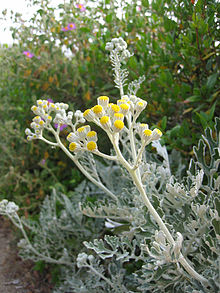- Jacobaea maritima
-
Jacobaea maritima 
Mature plant at Ghajn Tuffieha, Malta Scientific classification Kingdom: Plantae (unranked): Angiosperms (unranked): Eudicots (unranked): Asterids Order: Asterales Family: Asteraceae Tribe: Senecioneae Genus: Jacobaea Species: J. maritima Binomial name Jacobaea maritima
(L.) Pelser & Meijden (2005)Synonyms Othonna maritima L. (basionym)
Cineraria maritima (L.) L.
Senecio maritimus (L.) Rchb. [non L.f.]
Maritima bicolor Willd.
Senecio bicolor (Willd.) Tod. [non Viv.]
Senecio cineraria DC.
Cineraria gibbosa Guss.
Cineraria nebrodensis Guss.
Cineraria ambigua Biv.
Senecio bicolor subsp. cineraria (DC.) Chater
Senecio cineraria subsp. bicolor (Willd.) Arcang.
[1][2][3]Jacobaea maritima (Silver Ragwort) is a perennial plant species in the genus Jacobaea in the family Asteraceae, native to the Mediterranean region. It was formerly placed in the genus Senecio, and is still widely referred to as Senecio cineraria; see the list of synonyms (right) for other names.
It is widely cultivated as an ornamental plant for its white, felt-like tomentose leaves; in horticultural use, it is also sometimes called "dusty miller", a name shared with several other plants that also have silvery tomentose leaves; the two most often to share the name are Centaurea cineraria and Lychnis coronaria.
Contents
Description
 Flowers, Port-Cros National Park, France
Flowers, Port-Cros National Park, France
Silver Ragwort is a very white-wooly, heat and drought tolerant evergreen subshrub growing to 0.5–1 m tall. The stems are stiff and woody at the base, densely branched, and covered in long, matted grey-white to white hairs. The leaves are pinnate or pinnatifid, 5–15 cm long and 3–7 cm broad, stiff, with oblong and obtuse segments, and like the stems, covered with long, thinly to thickly matted with grey-white to white hairs; the lower leaves are petiolate and more deeply lobed, the upper leaves sessile and less lobed. The tomentum is thickest on the underside of the leaves, and can become worn off on the upper side, leaving the top surface glabrous with age. The flowers are yellow, daisy-like in dense capitula 12–15 mm diameter, with central disc florets surrounded by a ring of 10–13 ray florets, and enclosed in a common whorl of bracts at the base of the capitulum. The seeds are cylindrical achenes.[4][5][6]
Distribution
Jacobaea maritima is native to the western and central Mediterranean region, in northwest Africa (Morocco, northern Algeria, Tunisia), southern Europe (Spain, Gibraltar, southern France including Corsica, Italy including Sardinia and Sicily, Malta, Slovenia, Croatia, Bosnia, Kosovo, Montenegro, Serbia, Republic of Macedonia, Greece,), and the far west of Asia (Turkey). It occurs primarily on cliffs and rocky coastal sites, more rarely inland.[3][2][5]
It is also naturalised further north in Europe (north to Great Britain and Ireland, where occurring mainly in mild coastal areas[4][5]) and locally in North America.[7]
Ecology
As with many other densely tomentose plants, the tomentum on the leaves is used by some species of bees (e.g. Anthidium manicatum and Anthidium oblongatum in Megachilidae) for nest-building.[8]
Hybrids are known with Jacobaea erucifolia and Jacobaea vulgaris; the hybrid with J. vulgaris is fertile, producing a wide range of intermediate progeny.[4][5]
Cultivation and uses
Jacobaea maritima is widely used in horticulture for its silvery foliage. It is winter hardy in USDA Zones 8-10, tolerating winter temperatures down to -12° to -15° C,[6][9] tolerant of light shade but preferring full sun.[6] In colder areas it is grown as an annual plant. Many cultivars have been selected for particularly dense silvery tomentum, such as 'Cirrus', 'New Look', 'Ramparts', 'Silverdust', 'Silver Filigree', and 'White Diamond'.[6] It has been recommended in North America for its fire resistance[10] resistance to browsing by deer,[11] and its salt tolerance.[12]
References
- ^ Pelser, P. B.; Gravendeel, B., & van der Meijden, R. (2002). "Tackling speciose genera: species composition and phylogenetic position of Senecio sect. Jacobaea (Asteraceae) based onplastid and nrDNA sequences". American Journal of Botany (Botanical Society of America) 89 (6): 929–939. doi:10.3732/ajb.89.6.929. http://www.amjbot.org/content/89/6/929.full.pdf. Retrieved 2008-06-29.
- ^ a b Botanic Garden and Botanical Museum Berlin-Dahlem. "Details for: Jacobaea maritima" (HTML). Euro+Med PlantBase. Freie Universität Berlin. http://ww2.bgbm.org/EuroPlusMed/PTaxonDetail.asp?NameId=7002288&PTRefFk=7000000. Retrieved 2008-02-19.
- ^ a b Germplasm Resources Information Network (GRIN) (2007-05-04). "Taxon: Jacobaea maritima (L.) Pelser & Meijden" (HTML). Taxonomy for Plants. USDA, ARS, National Genetic Resources Program, National Germplasm Resources Laboratory, Beltsville, Maryland. http://www.ars-grin.gov/cgi-bin/npgs/html/taxon.pl?450258. Retrieved 2008-02-27.
- ^ a b c Interactive Flora of NW Europe: Senecio cineraria
- ^ a b c d Blamey, M. & Grey-Wilson, C. (1989). Flora of Britain and Northern Europe. ISBN 0-340-40170-2
- ^ a b c d Huxley, A., ed. (1992). New RHS Dictionary of Gardening. Macmillan ISBN 0-333-47494-5.
- ^ Natural Resources Conservation Service (NRCS). "PLANTS Profile, Senecio cineraria DC." (HTML). The PLANTS Database. United States Department of Agriculture. http://plants.usda.gov/java/profile?symbol=SECI2. Retrieved 2008-02-27.
- ^ Shane R. Miller, Robert Gaebel, Randall J. Mitchell, and Mike Arduser; University of Akron. "Occurrence of two species of Old World bees, Anthidium manicatum and A. oblongatum (Apoidea: Megachilidae), in northern Ohio and southern Michigan". The Great Lakes Entomologist 35 (1): 65–69. http://www3.uakron.edu/biology/mitchell/pdfs/Miller%20et%20al%202002.pdf. Retrieved 2008-03-03.
- ^ Senecio cineraria Cinéraire maritime
- ^ J. Knutson-Pedersen (July 2005). "Tree Notes" (PDF). Fire Safe Landscaping. Plumas Fire Safe Council. http://plumasfiresafe.org/Documents/treenote17.fire%20resits%20plant.3.pdf. Retrieved 2008-03-02.
- ^ F. W. Appleton (2003-09-29). "Coping with the deer by the use of deer resistant plants." (HTML). [PLANTanswers http://aggie-horticulture.tamu.edu/plantanswers/web.html]. Texas A&M University. http://aggie-horticulture.tamu.edu/plantanswers/publications/deerbest.html. Retrieved 2008-02-29.
- ^ York County Office. "Salt Tolerant Plants for Water-front Applications" (PDF). Archived from the original on 2007-10-24. http://web.archive.org/web/20071024172937/http://www.yorkcounty.gov/vce/progareas/hort/pubs/Salt+Tolerant+Plants+w+ltrhead.pdf. Retrieved 2008-03-03.
Categories:
Wikimedia Foundation. 2010.


